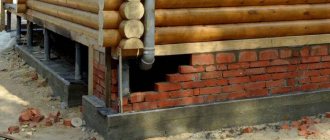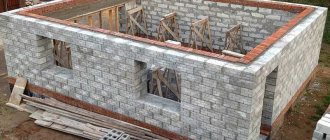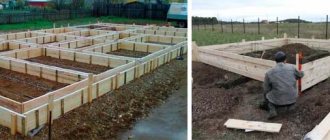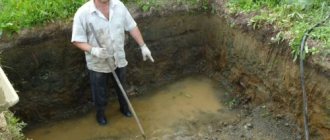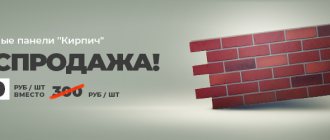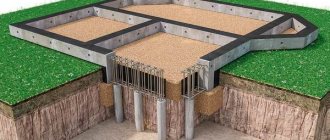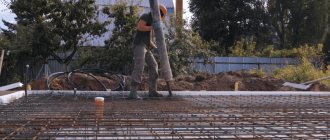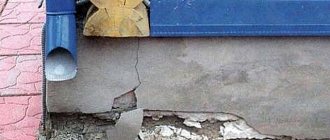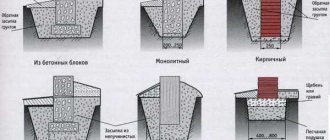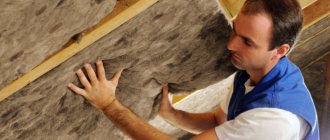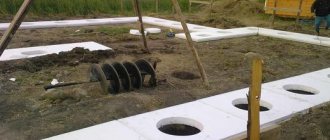Why insulate the foundation?
The first and most well-known reason why you should take a responsible approach to the issue of insulating the foundation of a house is the constant fluctuation in temperature and soil moisture . Natural phenomena provoke cracks in the foundation and its subsequent destruction.
The fact of energy saving may also seem important for a thrifty owner . a warm foundation will reduce heat leakage and save heating costs by a third.
In addition, an insulated foundation can protect :
- living quarters from penetration of low temperatures;
- communications from cold and moisture.
Insulating the foundation means protecting it not only from cold, but also from water .
Excess moisture can cause a lot of trouble to the foundation of the house and the house itself if the barrier is not taken care of in time.
Even based on these few examples, we can give a positive answer to the question: is it necessary to insulate the foundation?
Is it necessary to insulate the foundation of a house without a basement: interesting tips
The construction of any house, regardless of the material and number of storeys, begins with the laying of its load-bearing component - the foundation.
Every owner of a private home understands perfectly well the role insulation plays. But attention is most often paid to the windows, walls, ceiling, and the base of the building is skipped.
Especially in cases where the basement is not planned to be used or is completely absent. And, as practice shows, it is in vain.
After all, in order for heat to be retained in a building, it must first of all have a reliable, warm foundation. It is estimated that about a fifth of all heat from a room leaks through an uninsulated or insufficiently insulated foundation.
Therefore, to the question: “Is it necessary to insulate the foundation of a house without a basement?” There can be only one answer: “It is necessary.”
- Soil humidity and temperature values are constantly changing; an unprotected foundation is more susceptible to cracking, deformation and destruction;
- The insulated base contributes to more efficient heat conservation and reduced heating costs;
- Insulation and insulation help protect your home from cold penetration from the outside;
- Additionally, various communications are protected from sub-zero temperatures and moisture ingress.
Insulation external and internal.
Is it necessary to insulate the foundation of a house?
Insulation of the foundation from the outside is carried out before the floor is laid and the walls are erected. And you can do the internal work when it is not possible to do the external work, and if there is a basement in the house.
Both the first and second options are designed to :
- prevent the penetration of cold into the base structure and living quarters;
- prevent the flow of rain and melt water.
Separately, internal insulation contributes to :
- the formation of its own microclimate in the basement, which affects the microclimate throughout the house;
- formation of a reliable barrier to groundwater;
- preventing the accumulation of condensation on the basement ceiling and the formation of mold.
However, when choosing a method, one nuance should be taken into account . The difference between external and internal insulation is that the first method reliably prevents the influence of seasonal temperature changes on the foundation, while the second one is weak at this point.
When insulating the foundation from the inside, you need to be prepared for the fact that temperature fluctuations during the changing seasons can be fatal for the foundation and structure.
Is it necessary to insulate the strip foundation of a house?
Is it necessary to insulate the foundation of a house without a basement - options and materials
Reliable thermal insulation helps reduce heating costs in winter and keeps the inside of the house cool in hot summers. No one doubts that it is necessary when constructing a roof and a heated basement, in the design of entrance doors and panel walls. But there are different opinions about whether it is necessary to insulate the foundation of a house that does not have a basement. Some say that this is not necessary if a heat-insulating layer is installed under the floor of the lower floor. Others confidently state that, regardless of the presence of a basement, cold soil through an unprotected foundation will contribute to significant heat loss and structural destruction, so vertical insulation is simply necessary.
How to insulate different types of foundations?
During the period of laying the foundation of a house, the question should not even arise: is it necessary to insulate the foundation?
If you are building “to last,” then, undoubtedly, the intended service life of the building will, first of all, depend on the strength of the foundation. And also - warmth and comfort in the house.
Let's look at how to insulate various types of foundations . to protect the base from negative natural influences.
Shallow foundation.
It is used in the construction of light frame buildings and has two types: strip and tile.
The insulation is placed at a distance of 1-1.5 meters from the foundation masonry, and between them a zone of non-freezing soil is formed.
Columnar foundation.
To insulate this type of foundation, it is necessary to equip the so-called. a fence is a type of plinth, the main function of which is to protect the space between the soil and the foundation from moisture and freezing.
The collection process is labor-intensive . but during the operation of the building it will justify itself.
This is done like this:
- You need to dig a shallow (200-400 mm) trench.
- Fill the trench one third with sand or crushed stone.
- Attach bars with grooves (slots, slits) to the foundation pillars.
- Insert special thin boards into the grooves.
- Fill the lower part of the structure with expanded clay and your foundation will be out of danger.
Monolithic foundation.
Is it necessary to insulate the foundation of a house from the outside?
An excellent basis for compact buildings without a high base, a very popular type of foundation among domestic developers.
The technology for insulating a monolithic foundation is the most expensive, as it is produced using polyurethane foam. But, despite the high cost of such insulation, it is used with the prospect that the costs will pay off in the future.
The cost of heating a house when using this type of insulation is negligible.
Pile-vital foundation.
Buildings on such a foundation have one characteristic feature: an open space between the foundation and the ground, which always leads to significant heat losses. Insulation of the pile-vital foundation is mandatory, otherwise it will be very uncomfortable to live in the house.
- Grillage waterproofing.
- Installation of the thermal insulation layer.
- Finishing work on the outer layer of thermal insulation.
Foam plastic is usually used as a thermal insulation material in the process of insulating such a foundation.
Why insulate the foundation of a house? How to do this correctly?
The basis of any house is the foundation. The reliability and durability of the entire house depends on how correctly it is selected, designed and built.
There are no trifles in building a foundation. Each stage must be performed very carefully and carefully.
In this article we will look at a strip foundation, tell you why it is necessary to insulate it, how to do it correctly, and what material to choose as insulation.
Why insulate the foundation?
There are several important reasons that make foundation insulation one of the main stages of its laying.
Insulating the foundation protects it from destruction
It's no secret that the foundation of a house located in the ground is constantly subject to loads from soil, groundwater, and frost heaving forces.
All these loads are quite large and if they are not taken into account, then over time they will simply destroy the foundation, cracks will appear in the foundation, it may burst, sag at one angle, or groundwater will seep through the basement walls.
How will insulation prevent the foundation from such phenomena?
To understand these processes, you need to remember school physics. Everyone knows that when water freezes it expands and increases in volume. Thus, flowing into a small gap in the foundation and freezing, it widens this gap, which becomes larger every year. As a result, after a few years, a small gap will turn into a large one, thereby weakening the foundation in this place.
To prevent such results, it is necessary to remove the water located near the foundation or prevent it from freezing, but it is better to do everything in a complex.
There are a number of measures designed to protect the foundation from the destructive effects of water.
- Make drainage. Thus, we remove water from the foundation. On our website there is an article “How to make a drainage system.”
- Produce reliable waterproofing. This will prevent moisture from penetrating deep into the foundation. (link).
- Insulate the foundation. Our article is based on this option. The whole point is that insulation prevents water from freezing and, consequently, destroying the foundation.
Insulation is especially important when laying a shallow foundation, which we wrote about in one of the issues. (link). In it we told you that insulation allows you not only to protect the base, but to make it much cheaper.
Insulating the foundation reduces heat loss
According to experts, heat loss during the cold season through an uninsulated strip foundation can be up to 20%. As you understand, by insulating the base you can significantly save on heating the entire house.
What if the basement under the house is unheated?
In this case, insulating the foundation from the outside prevents the cold from passing into the underground space, thereby reducing heat loss through the floor of the first floor.
Insulation prevents condensation in the basement
Many people do not even assume that the appearance of condensation on the walls in the basement is associated precisely with the insulation of the foundation from the outside. Such damp walls cannot be decorated, painted or covered with anything. The surface will be constantly wet and the finishing layer will deteriorate or fall off. In addition, in such moisture-saturated rooms, mold often appears, which can be quite difficult to remove.
In such cases, the owners of the house begin to intensively heat the basement, but this only partially helps.
It's all about the dew point. For those unfamiliar with the concept, dew point is the temperature at which steam condenses and turns into water. So, in non-insulated walls it is located closer to the inside, on the side of the room. The task of the insulation is to move this dew point closer to the outer part of the wall and thus prevent condensation from occurring in the basement.
Insulation materials
Before considering the insulation process itself, you need to decide which material is most suitable for this, because the insulation will be located in rather difficult climatic conditions
The main properties that foundation insulation should have are as follows:
- Low water absorption. As you know, if the insulation contains water, it ceases to perform its main function
- Durability. Houses are built to last for many decades, so the durability of the foundation depends on the service life of each of its components.
- Compressive strength. This figure should be quite high, because the soil puts high pressure on the insulation and can simply crush and damage it. Such crumpled insulation becomes useless.
These are the main indicators that foundation insulation should have. The most suitable materials for these properties are foam glass and extruded polystyrene foam (EPS).
These are very good thermal insulation materials. You will have to choose based on price and availability.
Many people use ordinary polystyrene foam, popularly called polystyrene foam. The main disadvantage of this material is its high water absorption, and as we wrote above, this is not acceptable in such conditions.
Calculation of insulation thickness for plinth and foundation
We decided on the materials for insulation and identified two of them: foam glass and extruded polystyrene foam. Foam glass is still expensive, and the installation process is more labor-intensive, so it is not as popular as EPS.
In this chapter we will try to explain to you how to independently calculate the thickness of the insulation for an EPS foundation. The advantage of insulating them with this material is that you can do it yourself, it’s quite simple.
As you understand, the calculation for each type of foundation will be individual. The thickness of the thermal insulation is influenced by climatic conditions, material and thickness of the foundation.
The formula for calculation is given below.
δУТ = ( R0ТР - 0.16 - δ/λ ) x λУТ
At first glance, the formula is quite complex and many people think that it is quite difficult to calculate the thickness on their own, but we will try to simplify it a little.
Let's explain what each variable means and where you can find it.
Foundation insulation scheme.
For owners of private houses used for year-round living, the question remains relevant: is it worth insulating the foundation from the inside if it is already insulated from the outside?
For a greater heat-saving effect, you can carry out double-sided insulation of the base of the house. This is usually what thrifty owners do, caring about heat in their living rooms and not wanting to overpay for heat supply.
The scheme for insulating the foundation of a heated room combines two types of insulation: horizontal and external vertical.
Is it necessary to insulate a strip foundation? Is it necessary to insulate a foundation without a basement?
Insulating the foundation of a house without a basement - is it necessary?
Is it necessary to insulate the strip foundation of a house?
It is probably impossible to find a person who would not enjoy living in a cozy home. But after completing the construction of a home, many people have to deal with the problem of heat loss, both through the walls and through the foundation of the house. In this regard, the answer to the elementary question of whether it is necessary to insulate the foundation is obvious even if there is no base at the base. This must be done, and there are a number of good reasons for this.
Is it necessary to insulate the foundation in a house without a basement?
There are no specific recommendations on whether it is necessary to insulate the foundation of a cottage in the absence of a basement floor in the regulatory documentation of the joint venture or TSN. However, even if the building does not have a basement, the reinforced concrete structure represents a giant cold bridge. To eliminate heat loss, reduce heating costs and eliminate the forces of frost swelling, vertical and horizontal thermal insulation must be made.
Materials for base insulation.
Before you start insulating a house without a basement, you should figure out which materials are most appropriate to use in a particular case. Typically used as insulation:
There are two main types of insulation: external and internal.
External insulation of the base must be completed before the floor and walls of the future house are erected. The internal option is used only if the foundation and base cannot be insulated from the outside.
Insulation materials
The table shows the materials used for insulating foundations and their characteristics:
| № | Material | Characteristics |
| 1 | Expanded clay | It retains heat well and protects the foundation from moisture due to its porous structure that can absorb excess moisture. To achieve a better effect, insulation with expanded clay is carried out together with waterproofing of the base. |
| 2 | Expanded polystyrene | The most popular material for foundation insulation. Produced in the form of slabs, it is easily glued to the surface of walls and bases. Has high heat saving performance. Protects structures from destruction under the influence of moisture, temperature changes, and exposure to aggressive substances. |
| 3 | Polyurethane foam | Available in liquid form, applied by spraying onto the surface using a construction gun. After hardening, a monolithic coating with high thermal insulation characteristics is obtained. The composition fills all depressions, cracks, and pores on the base. Thanks to this method of application, it protects against the formation of condensation between the insulation and the foundation. |
| 4 | Bulk insulation from recycled materials | To save on insulation of a buried base, bulk insulation materials obtained from waste aerated concrete, foam concrete, and polystyrene foam are used. A waterproofing layer is laid on the outside, only after this the foundation is insulated. |
The choice of heat-saving material is influenced by many factors. You need to make a choice depending on climatic conditions, the proximity of groundwater, and the design of the house.
A good option for insulating the foundation is construction using permanent formwork made of polystyrene foam. It is quite expensive, but has a long service life and reliably protects the base from exposure to cold and moisture.
Types of foundations and specifics of their insulation.
Is it necessary to insulate the foundation of a house without a basement?
In modern construction, different types of foundations are used, some of which have a base, while others do not. Each of them uses its own insulation technology.
Insulation of the strip base.
When insulating the strip foundation of a house, work should be carried out evenly along its entire length. For this, the design requires preliminary preparation. First of all, a trench is dug around the entire perimeter of the house, the width of which is 1 m, and the depth is identical to the depth of the base. Then the structure is thoroughly cleaned of dirt and soil residues. Neglecting this procedure is strongly discouraged. Since only a cleaned surface can provide good adhesion to the material. If necessary, the surface of the foundation can be leveled using a cement screed.
Before proceeding directly to the insulation procedure, it is necessary to ensure reliable waterproofing of the base. Why this is necessary is quite obvious - so that the insulation is not exposed to water and moisture. For this purpose, the surface of the base should be thoroughly coated with mastic. Alternatively, you can use any other waterproofing material. After all the preparatory work has been completed, you can begin laying the insulation boards. It is attached with special glue. If you want to achieve the best result, it is highly recommended to lay insulation material in two layers.
The procedures described above are performed along the entire perimeter of the base.
Insulation of the columnar base.
Is it necessary to insulate the foundation of a house?
In order to insulate a column-type foundation, the first thing you need to do is make a base. Its main function is to protect the space between the base and the ground from the negative effects of moisture and freezing temperatures. To make a plinth, you will need to perform the following amount of work:
- dig a small trench under the house with a depth of 20 to 40 cm
- pour crushed stone or sand into the trench, the layer of which should be 5 cm less than the depth of the trench;
- attach special bars with grooves to the pillars of the base for attaching boards to them in the future;
- insert special beams into the grooves, on which the boards will then be attached;
- insert the boards into the grooves around the perimeter of the base;
- fill the lower part of the resulting structure with expanded clay.
By building such a base, you can be sure that your foundation is reliably protected from the cold.
Insulation of slab base.
Is it necessary to insulate the foundation?
Insulating the slab foundation of a house is the most expensive procedure compared to those described. Most often in this case , polyurethane foam is used to insulate the base . which is applied to the walls using a special device. It is most advisable to insulate the slab base before it is poured. To do this, a waterproofing layer is laid in a pre-dug pit (usually roofing material is used), polyurethane foam is placed, over which a screed is made. Next, reinforcement is laid and concreting is carried out.
Insulation of the pile foundation.
A pile foundation is characterized by the presence of open space between the soil and the foundation, due to which heat loss can be simply colossal. There is no need to say that such a foundation should be insulated without fail, since otherwise dampness and cold will constantly reign in the house.
Such bases are most often insulated using polystyrene foam. The insulation technique itself occurs in several stages:
- the foundation grillage is waterproofed;
- laying a layer of insulation;
- carrying out finishing work.
Why insulate?
A columnar foundation has a number of advantages over others: it is easy to create, the price is many times less than a monolith, it can be easily repaired and lasts up to 100 years. It must be insulated for the same purpose as the monolith - to minimize heat loss.
- Creating a reinforced concrete grillage greatly increases heat loss, because in cold months the concrete cools very quickly and literally begins to draw heat from the walls and floor of the house.
- If a metal or wooden grillage is chosen as the base, an air cushion is formed between the floor and the ground and constant air circulation occurs, and therefore in winter the floor and base of the walls of the first floor will be cold, even if you use the best thermal insulation material for interior decoration.
- All communications of the house pass just in the space under the house. By insulating the foundation, you will thereby protect communications from freezing and possible mechanical damage.
Insulation of the base from the inside.
Quite often, those who are involved in building a house ask themselves why it is necessary to insulate the base from the inside if there is external insulation. There is no definite answer to this question, but if you want to ensure maximum heat conservation in your home, you should still do this.
The most commonly used materials for internal insulation are polystyrene foam, polystyrene foam and polyurethane foam. The latter option is the most preferable, since it allows you to obtain a monolithic thermal insulation layer, and the material itself has a long service life.
Base insulation technology
The technology for insulating the foundation varies depending on the type of foundation and the heat-saving materials used.
Foundation insulation is divided into external and internal. The outer part of the base must be insulated before the construction of the base and walls.
If thermal insulation measures were omitted at the construction stage, insulation is done from the inside.
Thermal insulation of strip base
Many people ask the question why insulate the foundation of a house if there is no basement space. Moisture, penetrating through the pores of concrete, increases in size when freezing, which often leads to the formation of cracks.
The strip foundation is insulated with a uniform layer around the entire perimeter.
Step-by-step instruction:
- A trench is dug along the entire length of the foundation. Its dimensions should be: in depth, like a foundation, in width 80-100 cm.
- Clean the concrete strip from dirt, soil and dust.
- If necessary, the surface is leveled by making a concrete screed.
- Lay waterproofing from roll materials or treat the surface with bitumen-based mastics.
- The slab insulation is attached to a special glue.
When insulating the foundation with expanded clay, it is necessary to provide a drainage system to drain water from the base of the house. Expanded clay, due to its porous structure, is characterized by high moisture absorption, while it loses its thermal insulation qualities.
To install drainage, dig a trench at a short distance from the base of the house. The bottom of the pit should be located deeper than the base of the foundation. Cover the bottom with geotextile so that its edges touch the walls of the trench. Crushed stone is poured, pipes with a cross section of 10-20 mm are laid. They are covered with crushed stone on top. The protruding edges of the geotextile are folded so that they cover the drainage structure. A layer of sand is poured on top.
Expanded clay is poured to the level of the ground surface. It must be dry and clean, without foreign matter.
Pile foundation thermal insulation diagram
When using a material that is prone to increased moisture absorption as insulation, it is necessary to make a blind area. It will protect the expanded clay from getting wet during rain or melting snow.
Thermal insulation of pile foundation
In order to significantly reduce heat loss during the operation of the house, it is necessary to take measures for its insulation at the stage of construction of the pile-grillage foundation.
This type of foundation is characterized by the fact that there is a gap between the ground level and the floor of the house. In winter, the floor in such a house will be cold, and heating will be expensive. To reduce costs and create a favorable microclimate in the house, you need to insulate the grillage.
The grillage is a structure made in the form of a tape, connecting piles together. It takes on the load-bearing load from the house and distributes it evenly through the piles onto dense layers of soil.
At the installation stage of the piles, they are isolated from moisture. Roofing material or other material rolled into a pipe (with the rough side inward) is placed in the well. After this, the reinforcement is laid and the well is filled with concrete.
After installing the grillage, it is waterproofed and insulated. Most often, sheet polystyrene foam or polystyrene foam is used as heat-saving materials.
Insulation of slab foundations
The slab foundation has a large area, so its insulation is quite expensive. There is a lot of debate about whether it is necessary to insulate a foundation made in the form of a slab.
Heat-saving technologies make it possible to achieve a significant reduction in heat loss during the operation of the house. The investment pays off over time, and living in a warm home becomes more comfortable.
Insulation of the slab base is carried out after the bottom and walls of the trench have been leveled.
Step-by-step instruction:
- Lay strips of roofing felt overlapping by 150-200 mm.
- Sheets of polyurethane foam are laid on top.
- Fill the surface with cement screed.
- Install the reinforcement frame.
- The slab base is poured with concrete.
Base diagram
Thermal insulation of a columnar foundation
Before insulating the columnar base, a base is installed; it will prevent heat loss due to the gap between the floor of the house and the ground.
A trench is dug along the perimeter of the house, with a depth of 200 to 400 mm. Sand and crushed stone are poured into it so that the height of the layers does not reach the ground level by 50 mm.
They attach the bars to the posts and install the harness. After this, the surface is waterproofed and insulated.
When you need insulation of the foundation and basement outside and inside.
Is it necessary to insulate the strip foundation of a house?
An option for insulating a house without a basement along the perimeter of the installation.
The goal of any house construction is a beautiful, durable, and most importantly warm structure where you can live for a long time and comfortably. The use of which will be required in the construction of various types of technologies.
The surface of the earth tends to freeze in the winter, so it makes sense to lay insulation immediately during the construction of the supporting structure. The easiest way to insulate the foundation from the outside is to use several types of insulation that are suitable specifically for your construction option.
In what case and how to use it, it is worth understanding in advance, at the initial stage of construction. It is better to carry out the work while laying the entire foundation and concreting the blind area. This can avoid unnecessary costs in the future, for example, on the development of soil around the perimeter. Let's look at all types of available materials and insulation step by step.
The need for insulation if there is no basement
When designing and constructing a strip shallow foundation, they are guided by the standards SP 50-101. In principle, there is no basement in the MZLF, but building rules allow the implementation of the project only if measures are taken to reduce swelling:
- ring drainage around the perimeter;
- replacing the soil under the belt base with non-metallic material;
- backfilling of the sinuses with crushed stone and sand.
However, even in this case, these technologies partially solve the problem - they do not allow heaving soils to become saturated with moisture. Therefore, the TSN MF-97 standards recommend insulating the blind area of the house with a horizontal layer of polystyrene foam 60–120 cm wide around the perimeter at a depth of 30–40 cm.
For all these construction cycle operations, access to the side edges of the MZLF tape is provided. Therefore, at the excavation stage, you can easily cover the outer edges with high-density extruded polystyrene foam. It solves several problems:
- eliminates the cold bridge - floors become warmer, heat loss is reduced;
- protects waterproofing from possible tangential swelling forces;
- prevents freezing of concrete - if there is no waterproofing or it is broken, the structural material will absorb soil moisture, which, when frozen, increases in volume by 9%, leading to the opening of microcracks in the foundation structure.
Attention! Taking into account the above, external insulation allows you to increase the service life of a strip foundation by 30 - 40%, regardless of the presence of a basement floor.
Permanent residence house
For constant heating, even if the building does not have a basement, there are several options:
- floor on the ground on top of insulation - sheets of high-density extruded polystyrene foam (EPS) completely eliminate heat loss; the ground under the cottage can freeze through the uninsulated foundation and base, which are cold bridges;
- floor on the ground without thermal insulation - the heat loss of the building through the ceiling is maximum, the ground under the house cannot freeze;
- overlap along beams - insulation is present between the rough and finished floors by default, ventilation vents are mandatory in the basement, the soil and the MZLF concrete strip are guaranteed to freeze;
- The floor slab is the option with maximum heat loss; all structures below the slab will always be cold.
How to choose material for insulation.
Is it necessary to insulate the foundation of a house without a basement?
Schematic illustration of insulating a house without a basement.
When starting to lay a house, its design must be calculated in detail. At this stage, the question of choosing the insulation itself arises, deciding how to insulate the foundation of the house from the outside. Depending on the design of the supporting part, the material itself is selected. If a basement is present, it can be of several types: sheet, granular, sprayed. Let’s look at which insulation option to choose in more detail.
If you have a deep foundation, you can insulate it with bulk insulation. They are inexpensive and some can be made from recycled materials. For example, waste foam concrete or aerated concrete, foam granules are an excellent option to save money and insulate concrete. In the absence of this, insulation with sheets of polystyrene foam or polystyrene is considered cost-effective.
Insulation of a foundation without a basement
Let's start, perhaps, with a house made of wood. Insulation of the foundation of a wooden house is best done during the construction stage. Alas, many people come to their senses when the building is already erected. In this case, you should hurry before the cold weather sets in, otherwise you will have to heat the stove almost all the time. But, even if the cold has already hit the house, the point in thermal protection of the base still remains.
So, how to insulate the foundation of a wooden house? Many private buildings do not have basements. In this case, it is better to fill the empty space in the box (of which there is quite a lot) with something. Soil is also suitable as a material. On the one hand, this seems like a simple task, because after digging a pit there is quite a lot of soil left, and it will definitely be enough to carry out such work. But the problem is that the volume of soil that needs to be filled is very large, and all this will most likely have to be done manually.
If you need backfill material (as in this case), it is better to opt for expanded clay, especially since only 40 cm from the inside of the foundation walls are filled with it.
What other insulation materials are suitable for the foundations of wooden houses? As in any case, the choice depends on many factors. But most opt for materials such as:
Any of these insulation materials will cope with protecting the foundation of an old wooden house (as well as a new one too). You just need to accurately calculate their number, thickness, and also carry out the work correctly.
Now let's talk about whether it is necessary to insulate the foundation of a house without a basement. Disputes about this need continue to this day. But it’s still better to protect the base from the cold and here’s why:
- Without thermal insulation, you will experience heat loss, even if you take care of insulating walls and windows.
- The structure will be subject to temperature influences and may simply collapse along with the house.
It is quite possible to insulate the foundation with your own hands, especially during the construction phase. Then it’s better to do this. The point is not only that at this stage the work is easier. It happens that in an already built house, access to the foundation is only from the inside. But internal insulation gives a good effect precisely in buildings with basements.
The suitable materials are the same as in previous cases. This could be the same penoplex or polyurethane foam. In the first case, you can insulate the foundation with your own hands, in the other, although you will have to shell out a large sum and invite specialists, the result will be more effective, since all the cracks and seams will be sealed.
Measures to protect the basement from moisture.
Some insulation materials, such as expanded clay and aerated concrete, require preparation of laying sites. If you pour such material into your sinuses without proper preparation, it will simply absorb moisture and freeze.
Before starting the insulation process itself, you should lay a waterproofing barrier from rolled materials on the outside of the sinuses. Concrete around the perimeter, when using bulk insulation, is also treated with various mastics based on bitumen or liquid glass. Such measures will prevent the insulation from absorbing moisture from the concrete.
To what depth should the foundation be insulated from the outside - stroiliderinfo.ru
- Why insulate the foundation of a house?
- How to insulate the foundation of a house?
- The dangers of a perfectly insulated foundation
- How to protect the foundation of a house from frost heaving of the soil?
- How to prevent frost heaving of the soil?
At first glance, foundations do not need insulation, since they are located below ground level. Hence the question: is it necessary to insulate the foundation of a house , and if it is still necessary, then why and in what cases?
We can immediately assume the following answer: if there is no basement, there is no need to insulate the foundation, but it is enough to insulate the outer walls of the house and the floor (floor) of the first floor, and insulate the foundation itself only if there is a basement. But not everything is so simple, as read below.
An explanation just in case. Perhaps someone does not know: the foundation is what is below ground level; plinth - continuation of the foundation above ground level, to the bottom of the wall. “In common people,” the base is also usually called the foundation, but we will call them correctly, although the technologies and materials for insulating both are the same.
How to choose material for insulation
Schematic illustration of insulating a house without a basement
When starting to lay a house, its design must be calculated in detail. At this stage, the question of choosing the insulation itself arises, deciding how to insulate the foundation of the house from the outside. Depending on the design of the supporting part, the material itself is selected. If a basement is present, it can be of several types: sheet, granular, sprayed. Let’s look at which insulation option to choose in more detail.
If you have a deep foundation, you can insulate it with bulk insulation. They are inexpensive and some can be made from recycled materials. For example, waste foam concrete or aerated concrete, foam granules are an excellent option to save money and insulate concrete. In the absence of this, insulation with sheets of polystyrene foam or polystyrene is considered cost-effective.
What does foundation insulation provide?
Advantages of an insulated base:
- heat preservation in the house, warmer floors;
- gas consumption for space heating is reduced in winter;
- protection of communications;
- water will not freeze in the pipes.
When temperatures change, the material from which the house is built contracts/expands. This may cause cracks to form. Insulation helps to minimize the risks of violating the integrity of supporting structures.
External insulation helps protect the base from freezing; the dew point shifts towards the heat-insulating material, protecting the concrete strip from negative influences.
Measures to protect the basement from moisture
Some insulation materials, such as expanded clay and aerated concrete, require preparation of laying sites. If you pour such material into your sinuses without proper preparation, it will simply absorb moisture and freeze.
Before starting the insulation process itself, you should lay a waterproofing barrier from rolled materials on the outside of the sinuses. Concrete around the perimeter, when using bulk insulation, is also treated with various mastics based on bitumen or liquid glass. Such measures will prevent the insulation from absorbing moisture from the concrete.
When does the foundation of a house need thermal insulation?
The approach to thermal insulation of residential buildings depends primarily on the climatic operating conditions and geological parameters of the site; different regions have their own methods of protecting the buried part from freezing. In houses with basements, the question of whether it is necessary to insulate the foundation does not arise; covering the walls with moisture-proof materials with low thermal conductivity is often the only way to avoid dampness, fungus and destruction. In other cases, the expediency of extra spending should be justified.
The thermal insulation layer performs several functions: in addition to protecting against temperature fluctuations and humidity, it reduces energy losses through areas of the plinth and the floor in contact with the base line, protects communications and extends the service life of structures.
Expanded clay pillow.
Is it necessary to insulate the foundation of a house from the outside?
Sketch of the use of expanded clay for insulating a blind area.
Granules of ordinary expanded clay are often used as insulation, not only in their pure form, but also by introducing them directly into the concrete mixture. A lot depends on their quality; let’s take the main indicators we need.
The parameter for the general thermal conductivity of expanded clay materials differs, but the average value is 0.07 - 0.16 W/m C, where the smaller parameter exactly corresponds to its brand in terms of its density (M250). I would like to warn you right away that such material is not suitable for insulating a blind area; the constant presence of moisture will destroy the granules over time. It is perfect for keeping the basement warm.
Let's study what you need to consider when choosing expanded clay:
- It is necessary to take into account M 250, a rare brand, manufactured only to order. The usual density of the material is from 350 to M 600, respectively, then the coefficient is (from 0.11 to 0.14).
- The frost resistance of expanded clay and other porous fillers is designated by the letter F, a rather important indicator - when purchasing, make sure that the indicator is at least 15 cycles (F15), and it is better to choose a higher quality material.
- As for the work on the insulation itself. Having prepared 200-250 mm wide backfill openings around the perimeter and completely waterproofed them, you can fill the space.
During filling, it is necessary to compact the material layer by layer, every 30-35 cm of layer, use a tamper. This is especially true when there is a large amount of insulation, for example, around the basement.
Aerated concrete crumbs.
Is it necessary to insulate the foundation of a house without a basement?
Using expanded clay concrete chips to insulate the foundation.
Here you can use different methods. Arrange filling with pieces of aerated concrete, or you can drive it through a crusher, thereby obtaining a fine-grained powder. Both are suitable.
Some characteristics are interesting when choosing this insulation method. With a density of 500 and a thickness of 350 mm, the thermal conductivity of the filler will be 0.11−0.13 W/m C, exactly like expanded clay granules. Although the pricing policy is much better. Broken blocks can be purchased at a reasonable price at any wholesale building materials base.
Advice! Aerated concrete quickly absorbs moisture; if you decide to choose this particular material, carry out all waterproofing work at a high level. During use, the material must be dry, no more than 28% humidity. Then the service life will be decent, at least 25 years.
Work with it is carried out according to the same scheme as with the previous insulation. There is no point in insulating the basement inside if you carry out complete measures outside, from the bottom point of the foundation to the top point, to the level of the concrete blind area.
Extruded materials.
Is it necessary to insulate the foundation of a house from the outside with penoplex?
The use of extruded material to insulate the base of the house along the perimeter of the surroundings.
In cold climates, when the ground freezes to 1.5 - 1.8 degrees, there is a need to insulate all the concrete around the basement, as well as make surface insulation of the entire blind area. Expanded polystyrene fits all parameters, but it is not an economical option. But the service life is more than 50 years. Its density is 35 kg. per square meter, with a thickness of 50 mm, and moisture absorption is less than 3% per cubic meter, per day. Good parameters for insulating basements, semi-basements, plinths and concrete foundation slabs. It is also suitable for insulating blind areas. Work with it is carried out as follows:
- Prime the surface for insulation. Allow to dry for 24 hours.
- Coat the walls with bitumen mastic in 1-2 layers. The mastic must dry completely.
- Glue the sheets (standard size 0.5 x 1 m) at intervals using high-fix adhesive. After 2-3 days, holes are drilled for the fungi (a plastic dowel with a cap), and the dowels themselves are installed. Consumption of fasteners per 1 m² 7 − 10 pcs.
- Cover with a layer of mastic; the option of laying a special membrane is possible. The sinuses are backfilled, with layer-by-layer compaction of the soil. The sheets are installed above the zero level of the foundation, and subsequently the blind area insulation sheets are adjacent to it. Horizontal insulation under the concrete blind area is carried out to a width of 1.2 meters.
Important: Basement ventilation is a very important factor. If it is not properly arranged, the presence of capillary moisture from inside the basement or semi-basement is inevitable. Insulation of ventilation pipes is also carried out, but with rolled materials.
Thermal insulation of the basement in a permanent residence
A house in which people permanently live is heated; in this case, floor insulation is done in several designs, each of which has its own advantages.
Floor on the ground over a layer of thermal insulation
Sheets of extruded polystyrene foam reduce heat loss; the ground under the house can freeze strongly through the base and foundation, which themselves will be cold bridges;
Floor on the ground without thermal insulation
In this case, heat loss through the ceiling will be maximum, but the ground under the house does not freeze due to the heat transferred from the house.
Overlap on beams
Between the finishing and rough layers of floors in a private house, thermal insulation is installed in any case according to building regulations, and ventilation ducts must be installed in the basement. In this case, the soil and foundation will definitely freeze during constant frosts that last for several days.
Floor slab
The coldest option is when heat loss is maximum. All structures and surfaces located below the floor slabs will be cold.
If backfilling is done with soil that was removed from the pit during digging, then swelling of parts of the foundation becomes frequent. This is fraught with deformation and destruction of the floor covering screeds. All these problems can be eliminated by high-quality thermal insulation.
Vertical thermal insulation consists of gluing the outside surfaces with polystyrene foam, which insulates the base and facade of the house. Horizontal - insulates the blind area by 10 cm with polystyrene foam 1.25 meters wide with a depth of 0.5 meters.
Is it necessary to insulate the basement if there is no basement? The need for thermal insulation of a building becomes clear if we study the thermal contours of the structure:
- Geothermal heat is present in every area of the structure;
- Horizontal insulation retains the heat of the soil, preventing it from freezing;
- Vertical thermal insulation protects the structure and waterproofing layer from freezing during the cold season.
The horizontal contour made of polystyrene foam must be made monolithically, without joints or seams, therefore there are some features of laying slabs of the material:
- A thermal insulation layer is made under the base of the foundation along the entire perimeter of the pit and in part of the blind area, which will help retain heat under the entire house;
- Comprehensive protection against heat loss is done under the ground floor, the edges of the foundation from the inside, the outer sides of the foundation and under the blind area material to insulate the entire house and create a continuous line of the thermal contour.
If you do not thermally insulate the outer surfaces of a strip foundation with polystyrene foam, its destruction can occur even with high-quality waterproofing, well-equipped drainage systems, and when replacing the soil in the cavities with special materials.
Thermal insulation in houses with irregular heating
If the building is not used constantly, but is visited sporadically, then it is necessary, first of all, to heat the premises upon arrival. But when the owner leaves, the house cools down and does not heat up again until the next visit, thus, it can safely be classified as an unheated room, providing a thermal circuit using the technologies discussed above.
Insulated blind area
Reinforced concrete structures, which are massive, freeze much faster than their small counterparts. To do this, in any house without a basement you need to strengthen the thermal insulation in the corners. In this case, along the length of the polystyrene foam section in two layers, it is necessary to maintain a width of 3 times the size of the foundation tape, and the insulation placed according to the scheme must be placed on top of the first layer.
The given recommendations on how to insulate the basement of a house for buildings with different modes of use will help to significantly reduce the cost of operation and keep the building fit for habitation for a long time.
When the insulation of the blind area is sufficient.
There are many methods for carrying out such work; there is a more modern one. Spray liquid polystyrene directly onto the wall. If you decide to use this method, invite a company that has experience in this field. They will calculate all the insulation methods and choose the best option. They will draw up a project, find suitable material, and carry out all the necessary activities. A guarantee will be issued for all work performed.
Is it necessary to insulate the foundation of a house without a basement?
Based on experience in the middle zone, where the winter temperature (average) does not fall below 20ºC, shallow insulation of foundations is carried out to 1.2 - 1.5 meters below ground level. If you need to insulate the foundation of a house from the outside, use the option of surface insulation of the blind area.
Such measures are quite sufficient, because the temperature of the earth itself at a depth of 2.5 meters does not fall less than 8º above zero. Based on economic considerations, basement insulation at such a depth is not carried out at all.
Recommendation: A good long review article, from it you will find out whether it is necessary to insulate the foundation of a house without a basement. If you decide to insulate the foundation, be sure to take care to protect the insulation from moisture and destruction, and also make sure that there are no cold bridges. Moisture in the insulation during freezing and thawing will destroy the insulation, which will render the material unusable; it will simply stop insulating the foundation.
Insulation of various types of foundations
Since today there are several types of foundations that differ from each other in their designs, the insulation technology will be different for each of them, but its essence will come down to one thing - to protect the entire surface.
– insulation of strip foundation
As a rule, insulation of a house or foundation should be carried out evenly along the entire length of the strip base. To do this, the structure must first be prepared:
- Along the entire perimeter it is necessary to dig a trench about 1 m wide and a depth equal to the depth of the foundation.
- After this, the monolithic structure must be thoroughly cleaned of dirt and soil. This is necessary in order to obtain good adhesion between the material and the foundation surface. If necessary, the surface of the foundation is leveled using a cement screed.
- Before insulating the foundation, you need to take care of waterproofing. To do this, the surface of the foundation is coated with mastic or any other waterproofing material.
- Next, you can begin laying the insulation boards. Usually it is laid on special adhesive compounds. To achieve the best protection from cold and moisture, it is recommended to lay the insulation in two layers.
Such procedures must be performed along the entire perimeter of the foundation, trying to avoid gaps between the insulation, as this will lead to the formation of cold bridges. When the foundation is completely insulated, it is backfilled with soil.
– insulation of columnar foundation
How to insulate such a foundation of a house? To insulate a columnar foundation, you must first make a back-up (the so-called base). Its main function is that it protects the space between the soil and the foundation from moisture and low temperatures.
In order to make a pick-up, you must do the following:
- It is necessary to dig a small trench under the house, the depth of which will be about 20-40 cm.
- Next, sand or crushed stone layers of 15-30 cm are poured into it.
- Special bars with grooves are attached to the foundation pillars for further securing the boards to them. Thin boards are inserted into the grooves of the bars along the entire perimeter.
- Finally, the lower part of the structure is covered with expanded clay.
Having completed all these procedures, we can say with confidence that the foundation will be protected from moisture and low temperatures.
– insulation of slab foundations
Insulating a slab foundation is probably the most expensive of all types of foundations, but the costs will be fully recouped. In most cases, the base of a slab foundation is insulated with polyurethane foam. It is applied from a special device to the walls of the base.
Also, most often, they try to insulate a slab foundation even before it is poured, that is, they perform waterproofing from any material (most often roofing felt), after which foam plastic is laid in the foundation pit, on top of which a small screed is made. Next, reinforcement and pouring of concrete is done. You can also insulate a slab foundation on top of an already finished slab. This is recommended to be done in residential buildings for floor insulation.
– Insulation of pile foundations
A pile foundation most often has such a feature as an open space between the foundation and the ground. This indicates too much heat loss, so it is simply necessary to insulate this type of foundation, otherwise the house will be cold and damp.
Foam plastic is used as insulation for a pile foundation, and the insulation technology is carried out in several stages:
- Waterproofing foundation grillage.
- Laying insulation.
- Finishing work.
